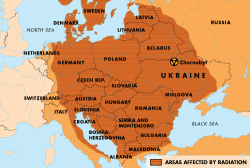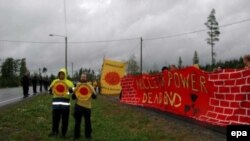Before the accident two decades ago, the country was planning to build its fifth nuclear power station, to supplement its growing energy needs. The new plant was supposed to be of Soviet design. But after Chornobyl, the government immediately abandoned the project.
In the mid-1990s, the idea was floated anew. Again, parliament voted it down. But in 2002, legislators approved construction of the new plant. And it's not just any plant.
When it is completed in 2009, Olkiluoto-3 will be the world's most powerful nuclear power station. It will also be among the world's most technologically advanced, built by a French-German consortium.
Gradual Change
So what changed? Public opinion, says Jorma Aurela, who is responsible for nuclear licensing at Finland's Ministry of Trade and Industry.
"In our country we have had opinion polls, you could say from the early 1980s, and it's easy to see how Chornobyl had a tremendous effect here and how [public opinion] has -- since then -- gradually changed," Aurela says.
Finnish voters now overwhelmingly back nuclear power, ironically for environmental reasons. Growing concerns about global warming and the need to reduce greenhouse gases under the Kyoto Protocol have played a major role in Finnish society's rethink on nuclear power.
Increasing Acceptance Of Nuclear Power
It's a rethink that's taking place in many other countries. The British government is preparing a review of its energy policies that many analysts expect to favor nuclear power. The United States, after a three-decade de facto moratorium on building nuclear plants, may soon approve new reactors.
Sweden has dropped plans to close its nuclear power plants by 2010. Switzerland has ended its moratorium on new nuclear plants. Discussions about reversing Germany's decision to close its nuclear plants have been revived. And in India and China, plans for a series of new nuclear power stations are going ahead.
Patrick Heren, a British energy consultant, says nuclear energy is increasingly seen as a way to achieve the twin aims of reducing carbon-dioxide emissions while satisfying growing energy demands.
"My sense is that what we might call the 'official classes' -- the administrators, the politicians -- see nuclear power as a fairly simple fix for two politically pressing problems: keeping the lights on and keeping the lights on without unduly damaging the environment," Heren says. "So I think the official mind is already pro-nuclear."
Heren says soaring oil and natural gas prices and worries about the reliability of suppliers are also playing a major role. "The recent publicity, for instance, about Russian gas deliveries has raised the whole specter of overreliance on natural gas which is delivered over a long distance from potentially unstable or unfriendly countries," he notes.
Economic, Safety Factors
Despite claims by the industry that today's plants are safer than ever before, going nuclear remains controversial. One thing hasn't changed since Chornobyl or the Three Mile Island accident in the United States that preceded it. Safety ultimately depends on the people operating the plants.
"One of the lessons of Chornobyl and of Three Mile Island and of other less-publicized incidents that have taken place over the last 30-40 years in the nuclear power industry, is the weakness of the human factor," Heren says. "There is always the human factor. That was very evident at Chornobyl."
Aside from safety, there is also the issue of economics. Nuclear power stations are relatively cheap to operate, a fact often cited by proponents of nuclear power.
But there are a lot of hidden costs. Building a nuclear plant is much more expensive than a coal or gas-fired one, due to all the sophisticated features required.
The costs of decommissioning a plant at the end of its production life and storing spent nuclear fuel must also be factored in, if the economic viability of nuclear power is to be assessed fairly.
"We're seeing now in various places, particularly as the older generations of power plants are coming to the end of their working lives, that there is an open-ended liability, particularly in regard to decommissioning, storing spent fuel and so forth," Heren says. "These are costs which are very, very substantial and which are also very difficult to quantify."
But Minister Aurela in Finland says that abandoning nuclear power is not an option. "We are trying to have a better program for renewables, we have subsidies for wind power, etc. We are trying to have an energy-conservation program and we are really trying to have new tools to curb our consumption and especially these greenhouse-gas emissions," she says.
"But still, we have to face the truth -- that there is a growing need [for energy],"says Aurela. "And that is why we have to say that from the government side, we are very happy now that this project is ongoing."
Chornobyl's Contamination Of Europe
 Click on the map to enlarge.
Click on the map to enlarge.
NOT JUST A LOCAL PROBLEM: On April 27, 1986, the day after the explosion at Chornobyl, workers at Sweden's Forsmark Nuclear Power Plant were found to have radioactive particles on their clothes, which led to a search for the source, and the first suspicions that a nuclear accident had occurred in the Soviet Union.
The cloud of radioactive particles from Chornobyl passed over Scandinavia, the Netherlands, Belgium, and the British Isles, before the wind changed, after which it was blown south over much of Europe. Radioactive contamination from the Chornobyl disaster was also detected as far away as North America and Japan.
LOCAL COVERAGE: Click here to see RFE/RL's coverage of Chornobyl in Russian, Ukrainian, or Belarusian.
 Click on the icon to view the slideshow
Click on the icon to view the slideshow

















